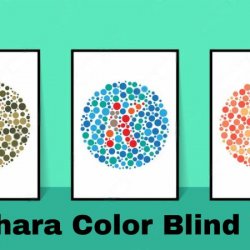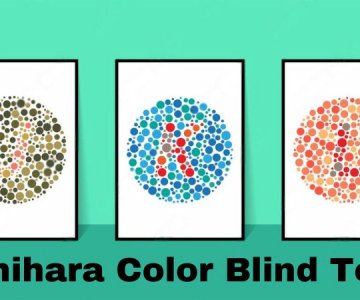Ishihara Color Blind Test Unleashed: A New Perspective

 Color perception is as subjective as it is fascinating. Yet, for a small percentage of people, colors can become an enigma. This color perception distortion, broadly labeled as color blindness, can largely impact routine tasks. One sophisticated tool in understanding this phenomenon is the Ishihara color blind Test.
Color perception is as subjective as it is fascinating. Yet, for a small percentage of people, colors can become an enigma. This color perception distortion, broadly labeled as color blindness, can largely impact routine tasks. One sophisticated tool in understanding this phenomenon is the Ishihara color blind Test.
The Ishihara color blind test is a diagnostic tool used to identify color vision deficiencies, particularly red-green color blindness.
The Genesis Of The Ishihara Color Blind Test
Shinobu Ishihara was born on January 26, 1879 in the town of Aomori in Japan. He was the oldest son of a farmer, who encouraged him to study as much as possible due to his poor health.
Ishihara graduated from Keio University Medical School (Keio Dentistry School) in 1903 and became an assistant professor at Keio University School of Medicine and Dentistry. In 1916, he became a professor at Keio University Dental College (now Faculty of Dentistry, Tokyo Medical and Dental University).
In 1917, Ishihara published his first book titled “On color vision” at the age of 38. This book included a test for color blindness which subsequently became known as the “Ishihara Color Blind Test”. This test was based on his own research into color vision deficiency (color blindness). It was later found that Ishihara had protanopia (red-blindness) himself.
In 1920, he published his second book titled “Color Vision Deficiency Diagnosis.” This book was based on his clinical experience with over 10,000 patients who suffered from red-green color vision deficiency (color blindness). The book also included several other tests for diagnosing color vision deficiency (color blindness).
The term “Ishihara Color Blind Test” became popular in Japan as a result of this book. In 1922, Ishihara published his third book titled “Color Vision Deficiency.” This was the first time that Ishihara had written about color vision deficiency (color blindness) in English. It was also the first time that he had published any research on color vision deficiency (color blindness) outside of Japan.
How Does The Ishihara Color Blind Test Work?
Color Perception
Our perception of color is essentially a cacophony of light waves interpreted by our brain. Yet, what happens when this process is disrupted? This is where the Online Ishihara Color Test comes into play.
The Color Blind Test Procedure
The test consists of a series of plates with dots on them. The plates contain numbers that have been made up of dots in different combinations. The person being tested will see the number as it appears on the plate, but those who are color blind will not be able to see certain combinations of dots.
Step 1: Look at each plate or card and find out if you can identify the numbers hidden within it. There may be one, two or three numbers on each card. You should not use any magnifying glass or other aids to help you read the plates or cards better.
Step 2: If you see no number on any of the plates or cards, then you are likely to have normal color vision and there should not be any further diagnostic testing done on you. If however, you do see a number on some of them, then read on as it may indicate an underlying problem with your ability to see certain colors clearly.
Where To Take The Test?
Optometrist or Ophthalmologist’s Office

The most common place to take the test is at an optometrist or ophthalmologist’s office. Eye care professionals have the necessary training and expertise to administer the Test properly and interpret the results accurately. Regular eye check-ups often include the Test, especially if you’ve expressed concerns about your color vision.
Online Testing
In the digital age, you can also take the Ishihara Color Blind Test online. Several websites and mobile apps offer virtual versions of the test. However, please note that an online test should only be used for an initial assessment. In case the online test suggests color vision deficiency, it should be confirmed by a test administered by an eye care professional. Monitor settings and ambient light can affect your results in an online test.
Schools and Occupational Health Centers
In schools, the Free Ishihara Color Blind Test can be administered during routine health check-ups by school nurses or other healthcare professionals. Certain occupations, especially those where color discrimination is crucial—like pilots, electricians, or graphic designers—may require a color vision test like the Ishihara Clolor Blindness Test. Occupational health centers often include the test in their health assessments.
Deuteranopia And Protanopia
Understanding Red-green Color Blindness
Red-green color blindness is a common form of color vision deficiency. It’s the most common type of color vision deficiency and affects around 1 in 12, about 8% of men and 0.5% of women, meaning there are an estimated 28 million people in the US with some form of red-green color blindness.
When red-green color blindness is present, there are two types: deutan (green weak) and protan (red weak). Each type is characterized by its own unique pattern of color vision deficiency.
The Difference Between Deutan And Protan
Deutanopia: Red Weakness
Deuteranomaly is the most common form of red-green color blindness. It affects 5% of males and 1% of females worldwide.
A person with deutanopia (deutans or red weak) has difficulty discriminating red and green colors. They may see a mixture of yellow and blue when looking at green objects or a mixture of orange and violet when looking at red objects. This is because this type of color blindness does not affect the ability to discriminate blues from yellows or oranges from violets; rather it affects only the ability to distinguish between reds and greens.
Protanopia: Green Weakness
Protanomaly is much less common than deutarnomaly but still affects about 2% of males worldwide.
A person with protanopia (protans or green weak) has difficulty discriminating blues from yellows but can distinguish between reds and greens easily. Protanopes often confuse gray with white, so printed material may appear as if it were printed on a gray background rather than white paper.
How Test Detects These Types Of Color Vision Deficits
The test consists of a series of plates containing different numbers and arrangements of colored dots or symbols that can only be seen by those with normal color vision.
Each plate contains a number or symbol that appears as a particular pattern when viewed by someone with normal red-green perception; however, this same pattern will seem random to someone with red-green color blindness since they cannot see certain colors as well as people with normal vision can.
The plates are arranged in order of difficulty (easy to difficult), so that a person who is completely color blind will only see the most basic patterns on the plates, whereas those with normal color vision should be able to see more complex patterns.
Test Results And Next Steps
Analyzing The Test Results
- If, after taking the test, you find it difficult to distinguish numbers or paths in a majority of the plates, it could suggest that you have color blindness.
- Your inability to identify specific color patterns or numbers on plates featuring shades of red or green could point towards Protan or Deutan-type color blindness, respectively.
- The extent of the numbers or paths you miss throughout the test could be indicative of the severity of your color blindness.
Consulting With A Professional
Should your Ishihara plates test suggest red-green color blindness, seeking professional advice is key. Follow these steps:
Identify a Specialist: Search for an ophthalmologist or optometrist experienced in color vision. You may find one online or request recommendations.
Schedule an Appointment: After selecting a specialist, book a meeting. Be ready to describe the nature of the test you took and its outcomes during this process.
Organize Your Test Results for The Visit: Carry along the results of your Ishihara color blindness test during your appointment day for reference.
Meet The Specialist: The specialist will likely conduct a detailed eye examination and a color perception test during your visit to confirm your earlier diagnosis.
Discuss The Findings: Post examination, the specialist will review the results with you, illustrating the nature and degree of your color vision deficiency. They will also provide suggestions on coping with this condition.
How To Pass Ishihara Color Blind Test
If you have color blindness, the Ishihara color blindness test might pose a challenge. Here are some strategies that might help:
Remember the Plates: One suggestion from a Reddit user is to familiarize yourself with the patterns in the Ishihara plates. By recognizing how the dots are arranged in specific parts of each plate, you may be better able to deduce the concealed numbers.
Create Optimal Test Conditions: Make sure your testing environment has a mild, natural light and no glare, as lighting can greatly impact how you perceive the colors on the plates.
Use Visual Assistance: Color-blind contact lenses, which leverage specialized filters, might enhance color perception, potentially assisting in distinguishing colors during the Ishihara color test. These contact lenses can be particularly beneficial for those who need to pass color vision tests for professional reasons.
FAQs
What Is The Ishihara Test And Why Is It Important?
The Ishihara Test is a diagnostic tool designed to detect color vision deficiencies, particularly red-green color blindness. It’s crucial as color perception plays a significant role in various professions and daily activities, and identifying color vision deficiencies can help individuals understand their visual limitations and seek appropriate support.
Who Developed The Ishihara Test?
The Ishihara Test was developed by Shinobu Ishihara, a Japanese ophthalmologist, in the early 20th century. His pioneering work in color vision research led to the creation of this widely used test, which bears his name.
How Does The Ishihara Test Work?
The test comprises plates with dots forming numbers or patterns. Those with normal color vision can discern these numbers, while those with color vision deficiencies may struggle to see them. The plates are designed to reveal specific types and degrees of color blindness.
What Are The Different Types Of Red-green Color Blindness?
Red-green color blindness encompasses two main types: deutan (green weak) and protan (red weak). Deuteranopia affects the ability to distinguish red and green, while protanopia affects discrimination between blue and yellow.
What Should I Do If I Suspect I Have Color Blindness Based On Ishihara Test Results?
If the Ishihara Test indicates color blindness, it’s essential to consult with an ophthalmologist or optometrist experienced in color vision. They will conduct further assessments to confirm the diagnosis and provide guidance on managing the condition.
Conclusion
Ishihara color blind test is a popular way to test color blindness. It gives us insight into how people with red-green color blindness, corresponding colors are difficult for them to distinguish. It makes our understanding of color perception a little less gray.
I hope that this article will help both those who genuinely intend to pass the Ishihara color test and those who are just looking to ensure that correct diagnosis is conducted. Hopefully, those that learn from this guide will be more prepared for the test than many of those that have taken it in the past.


Hej, dette er en kommentar.
For at komme i gang med at moderere, redigere og slette kommentarer, skal du gå til kommentarskærmbilledet i kontrolpanelet.
Kommentaravatarer kommer fra Gravatar.